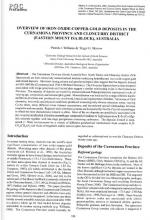Добрый день, Коллеги. Важное сообщение, просьба принять участие. Музей Ферсмана ищет помощь для реставрационных работ в помещении. Подробности по ссылке
Overview of iron oxide-copper-gold deposits in the Curnamona province and Cloncurry district (Eastern mount Isa block), Australia
The Cumamona Province (South Australia/New South Wales) and Cloncurry district (NW Queensland) are both extensively metasomatised terrains containing hydrothermal iron oxide copper-gold and related deposits. Structural timing criteria and geochronological data suggest that the deposits formed at 1630-1600 Ma (Cumamona) and 1540-1500 Ma (Cloncurry). The Cloncurry deposits have a close temporal association with I-type granitoids and limited data suggest a similar relationship exists in the Cumamona Province. The majority of deposits are hosted by metamorphosed Palaeoproterozoic supracrustal rocks of varying age, composition and metamorphic grade. Mineralisation was localised by a range of brittle-ductile and brittle structures and produced vein, stockwork, breccia and replacement orebodies. Variations of fluid chemistry, host rocks and physical conditions produced mineralogically-diverse alteration zones, varying Cu:Au ratios, many different minor element associations, and inconsistent spatial relationships between magnetite and ore metals. Regional-scale alteration systems are dominated by Na-(Fe-Ca)-rich assemblages in which the most characteristic mineral is albite. Most of the ore deposits are specifically associated with pre- to synmineralisation alteration assemblages composed of medium to high temperature K-Fe-(Ca-Mg)-rich minerals together with late-stage parageneses containing carbonates. The deposits formed in deep-seated (> 5km) environments by a variety of different geochemical mechanisms from complex H,0-C02±CH4±N2-saIt fluids of magmatic and/or metamorphic derivation .




